
Abraham Teerlink (Dordrecht, 5 November 1776) - Rome, 26 May 1857 [1] or July 1857 [2] ) was a 19th-century painter and draughtsman from the Netherlands.

Abraham Teerlink (Dordrecht, 5 November 1776) - Rome, 26 May 1857 [1] or July 1857 [2] ) was a 19th-century painter and draughtsman from the Netherlands.
Abraham Teerlink jr. was the son in the middle-class family of Abraham Teerlink sr. and Johanna Smits. [2] After showing an interest in the arts, he was tutored by Michiel Versteegh [3] and later by J. Kelderman and Arie Lamme. He started with copying works of famous artists (under supervision of the mentioned tutors), [4] but developed into a landscape painter, with his own compositions of landscapes often with cattle. In 1807 he received as one of three young painters in the Kingdom Holland a Prix de Rome, and hence received from King Louis Napoleon a stipend to travel to and study in Paris and Rome. He left for two years to Paris and Rome. In Paris he spent 1,5 year, copying and studying paintings from the Louvre and the Academy under supervision of the popular professor Jacques-Louis David, along with his compatriot from Dordrecht, Leendert de Koningh. He then travelled to Rome where he was able to find work in 1809, and remained there longer than planned. Once abroad he also spent time on poetry (in French). [2] [3]
In 1810 he settled definitively in Rome, though he continued to enter art competitions in the north. In 1836 he married the artist Anna Muschi and in 1839 he was awarded a knighthood in the Order of the Dutch Lion from King William I of the Netherlands. [2] Teerlink never returned to the Netherlands, but did submit works for exhibitions in the Netherlands, which gained him wide recognition. In Rome he became a professor of fine arts. [1] He was made an honorary member of the Koninklijke Academie voor beeldende kunsten te Amsterdam (Royal Academy of fine arts in Amsterdam) and of several Italian painter academies. [2]
Aelbert Jacobszoon Cuyp or Cuijp was one of the leading Dutch Golden Age painters, producing mainly landscapes. The most famous of a family of painters, the pupil of his father, Jacob Gerritszoon Cuyp (1594–1651/52), he is especially known for his large views of Dutch riverside scenes in a golden early morning or late afternoon light. He was born and died in Dordrecht.

Nicolaes Pieterszoon Berchem was a highly esteemed and prolific Dutch Golden Age painter of pastoral landscapes, populated with mythological or biblical figures, but also of a number of allegories and genre pieces.

The Hague School is a group of artists who lived and worked in The Hague between 1860 and 1890. Their work was heavily influenced by the realist painters of the French Barbizon school. The painters of the Hague school generally made use of relatively somber colors, which is why the Hague School is sometimes called the Gray School.
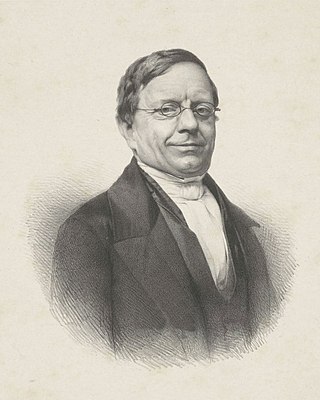
Abraham Jacob van der Aa was a Dutch writer best known for his dictionaries, one of notable people and the other of notable places in the Netherlands.

Jan Pieter Veth was a Dutch painter, poet, art critic and university lecturer. He is especially noted as a portrait painter. Amongst his sitters were Max Liebermann, Lambertus Zijl, Frank van der Goes, Antoon Derkinderen and other contemporaries including various fellow painters.
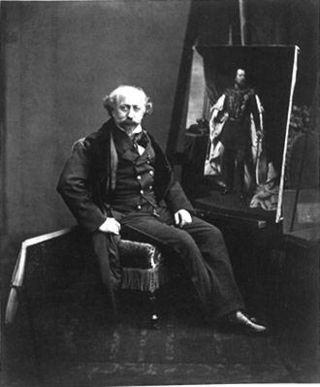
Nicolaas Pieneman was a Dutch painter, art collector, lithographer, and sculptor.
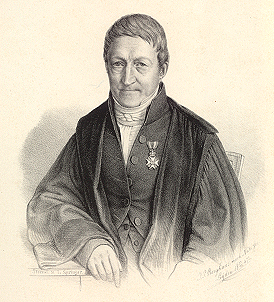
Matthijs Siegenbeek was a Dutch academic. From 1797 to 1847 he was the first professor of the Dutch language at the University of Leiden. From 1803 he was the member, then secretary, of the head-office of that university's literary faculty. Initially he was a Mennonite voorganger in Dokkum.
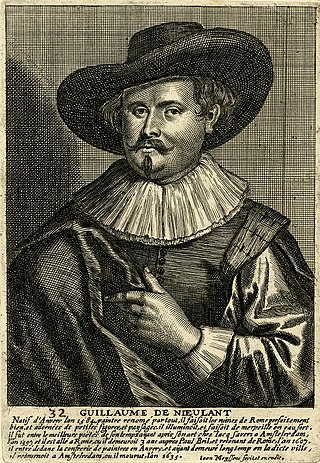
Guilliam or Willem van Nieulandt or van Nieuwelandt (1582/84–1635) was a Flemish painter, engraver, poet and playwright from Antwerp. He spent two thirds of his career in the Habsburg Netherlands and the remainder in Italy and the Dutch Republic. He is known for his Italianate landscape paintings and prints, often real views or capricci of landscapes and buildings from in or around Rome enlivened by contemporary figures or biblical or mythological scenes. He is regarded as the principal poet and playwright active in the Habsburg Netherlands in the first three decades of the 17th century.
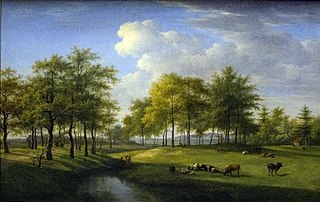
Gerrit Jan Michaëlis, was an 18th-century painter from the Northern Netherlands.
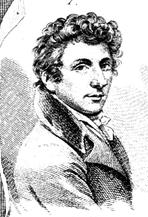
Woutherus Mol was a painter and draftsman from the Netherlands. He is known for interiors and genre scenes.

Albertus Brondgeest was a Dutch art trader, drawer and painter, primarily known for his landscapes. He was a pupil of Pieter Gerardus van Os, but also studied with Wouter Johannes van Troostwijk.

Volkert Simon Maarten van der Willigen, sometimes referred to as Volcardus Simon Martinus van der Willigen, was a Dutch mathematician, physicist and professor.
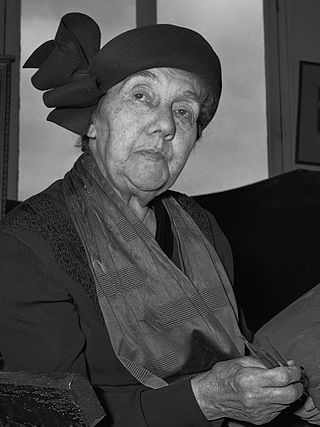
Jacoba Johanna (Coba) Ritsema, was a portrait painter from the Netherlands.

The Eerste Schilderijenzaal, or Painting Gallery I, is one of two art gallery rooms in Teylers Museum and is the oldest art gallery for contemporary Dutch art in the Netherlands. It was built onto the back of Teylers Oval Room in 1838. It was the young museum's first exhibition space for paintings and could be entered through the Oval Room, which was itself located behind the Fundatiehuis, the former home of Pieter Teyler van der Hulst.

Abraham de Vries was a Dutch Mennonite minister, author on literature and member of several societies.
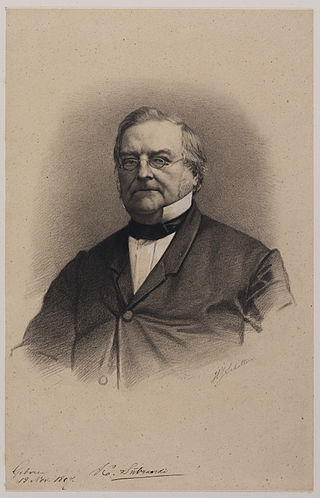
Klaas Sybrandi, also spelled as Sijbrandi, was a Dutch Mennonite minister, author, translator and involved with several societies and foundations.
The Dutch Prix de Rome is based on the originally French Prix de Rome and is awarded annually to architects and artists younger than 35. The award was initiated in 1807 by Louis Bonaparte, then ruler of the Kingdom of Holland, and confirmed after independence by William I of the Netherlands. It was canceled in 1851 by the statesman Johan Rudolph Thorbecke and reinstated in 1870 by William III of the Netherlands. Since then the winners are selected by the Rijksakademie in Amsterdam.
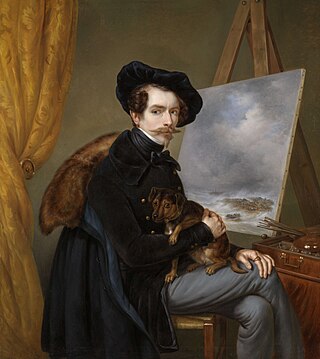
Johan Hendrik Louis Meijer was a Dutch painter, etcher, lithographer, and draftsman. He painted in the Romantic tradition and is best known for his seascapes.

Constant Cornelis Huijsmans was a Dutch art teacher and painter, whose roots go back to the seventeenth-century Antwerp of the landscape painter Cornelis Huysmans (1648–1727). Paintings of the latter are to be found at the Louvre in Paris and at the Hermitage Museum in Saint Petersburg, Russia. Earlier generations of the Huijsmans family used to spell their family name slightly differently, as Huysmans.

Simon Moulijn was a Dutch painter, draughtsman and graphic artist. He was one of the eminent visual artists of his time and became especially well known for his lithographic works.